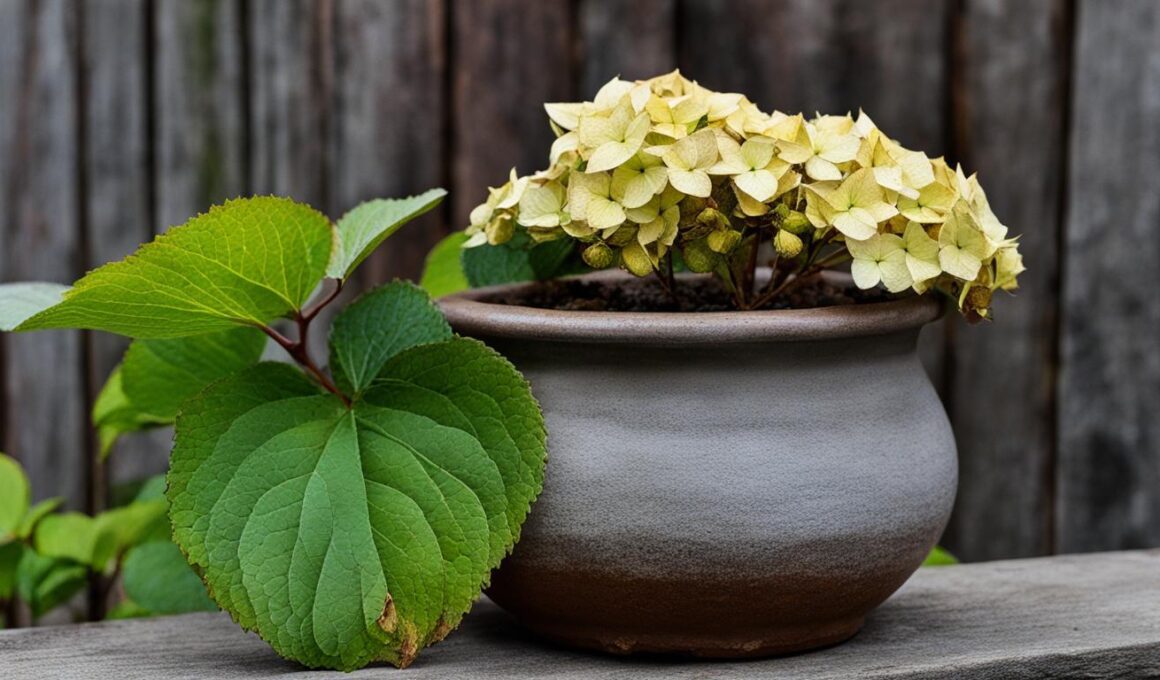Hydrangeas are a popular choice for gardeners looking to add vibrant blooms and lush foliage to their outdoor spaces. These stunning plants are known for their ability to thrive in various environments, making them versatile and adaptable. However, when it comes to growing hydrangeas in pots, you may encounter some unique challenges.
If you’re facing problems with hydrangeas in pots, don’t worry! In this article, we’ll explore common issues that arise when growing hydrangeas in containers and provide you with valuable care tips and fixes to help you overcome these challenges.
From drooping leaves to yellowing foliage and the frustrating lack of blooms, we’ll cover it all. Whether you’re a seasoned gardener or new to the world of hydrangeas, our expert advice will guide you towards keeping your potted hydrangeas healthy, vibrant, and thriving.
So, let’s dive into the world of hydrangea pot troubles and discover the care tips and fixes that will make your potted hydrangeas the envy of the neighborhood!
Drooping Leaves: Causes and Solutions
One common problem with hydrangeas in pots is drooping leaves. This is often caused by a lack of water, especially if the plants are exposed to too much afternoon sun. Hydrangeas thrive in partial shade with 4-6 hours of morning sunlight.
To remedy drooping leaves, it is important to water hydrangeas properly. Avoid watering the leaves to prevent fungal diseases and aim the water towards the base of the plant instead. Soaker hoses or drip irrigation systems can be effective watering methods. Hydrangeas need regular watering even after they are established to ensure proper blooming.
- Water hydrangeas properly, avoiding the leaves
- Aim the water towards the base of the plant
- Consider using soaker hoses or drip irrigation systems
- Ensure regular watering for established hydrangeas
Yellowing Leaves: Causes and Solutions
Another common problem with hydrangeas in pots is yellowing leaves. This can be caused by various factors, including excess water, iron deficiency, and high soil pH.
If the soil does not drain well, hydrangeas may be receiving too much water, which can lead to root rot. To address this issue, ensure proper drainage for your potted hydrangeas by using well-draining soil and adding drainage holes if necessary.
An iron deficiency can also result in yellowing leaves with green veins. To remedy this, you can use iron-tone or a high iron fertilizer specifically designed for acid-loving plants like hydrangeas. Follow the instructions on the packaging for the appropriate application.
High soil pH can contribute to yellowing leaves as well. Adding a soil amendment like aluminum sulfate can help lower the pH and create a more acidic environment, which hydrangeas prefer. It is important to follow the recommended dosage and application instructions when using soil amendments.
Proper watering and soil amendments are key to preventing yellowing leaves in hydrangeas. Be mindful of the moisture levels in the soil and adjust your watering schedule accordingly. Regularly monitor the soil pH and nutrient levels to ensure a healthy growing environment for your potted hydrangeas.
Lack of Blooms: Pruning and Nutrient Imbalance
One of the most common complaints about hydrangeas is the lack of blooms. This can occur for two main reasons: incorrect pruning and nutrient imbalance.
Hydrangeas that bloom on old wood should be pruned shortly after blooming to avoid snipping off flower buds. Incorrect pruning can result in the removal of the buds that would have produced beautiful blooms. To ensure optimal blooming, it is important to understand the specific pruning requirements of your hydrangea variety. Pruning guidelines may vary depending on whether your hydrangea blooms on old or new wood.
Additionally, a nutrient imbalance can also prevent hydrangeas from blooming. Nitrogen imbalance and phosphorus deficiency are two factors that can impact blooming. Too much nitrogen in the soil can promote excessive leaf growth at the expense of flower development. This is why it is essential to choose a fertilizer with high phosphorus content, as phosphorus promotes strong root development and vibrant blooms. Avoid late summer fertilization, as it can disrupt the natural blooming cycle of hydrangeas.
By ensuring correct pruning techniques and maintaining a balanced nutrient profile in the soil, you can encourage proper blooming in your hydrangeas, resulting in a stunning display of flowers.
- Incorrect pruning can hinder flower bud development.
- Prune hydrangeas that bloom on old wood shortly after blooming.
- Understand the specific pruning requirements for your hydrangea variety.
- Avoid excessive nitrogen fertilization, as it can inhibit blooming.
- Choose a fertilizer with high phosphorus content to promote vibrant blooms.
- Avoid late summer fertilization to maintain the natural blooming cycle.
Can Using Sugar Water Help with Hydrangea Pot Troubles?
Using sugar water for plants, especially hydrangeas, can be a helpful trick for resolving pot troubles. By mixing a small amount of sugar with water, you can provide your hydrangeas with a quick energy boost and help them recover from wilting or drooping. Just be sure not to overdo it!
Conclusion
Troubles with hydrangeas in pots can be easily addressed with proper care and maintenance. By understanding common problems like drooping leaves, yellowing leaves, and lack of blooms, you can take proactive measures to keep your hydrangeas healthy and vibrant.
When it comes to caring for hydrangeas in pots, one of the most important factors to consider is watering. Proper watering practices, such as watering at the base of the plant and avoiding wetting the leaves, can prevent issues like fungal diseases and ensure that your hydrangeas receive the right amount of moisture they need.
Additionally, it’s crucial to provide your hydrangeas with the right nutrients. Use fertilizers specifically formulated for hydrangeas or choose options high in phosphorus to encourage blooming. Checking and adjusting the soil pH can also help prevent yellowing leaves and nutrient deficiencies.
By following these care tips and implementing the necessary fixes, you can enjoy the stunning beauty of hydrangeas in pots and ensure their longevity in your garden. With proper care and attention, your hydrangeas will thrive, delighting you with their vibrant blooms year after year.









